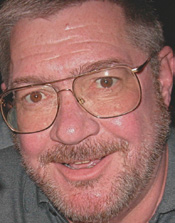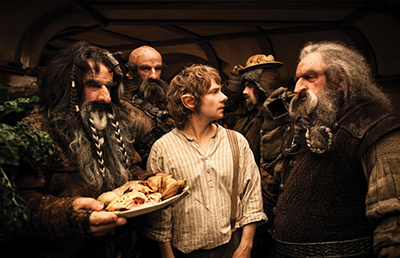High Frame Rate—What Is Enough?

Jay Ankeney
Hollywood is all aflutter over a new leap forward in technology. With 3D becoming a blasé part of the mainstream and 4K still a distant dream, the hot topic among the Tinsel Town production community is high-frame rate)—shooting and exhibiting films at frame rates from 48 fps or 60 fps and even up to 120 fps. This proposal could draw audiences back into theaters.
The technology is already here since most digital cinema cameras can easily be over-cranked and almost all second-generation digital projectors can ramp up to at least 48 fps playback with just a software upgrade. But, the crucial question is whether flipping more frames past a lens actually improves the viewing experience.
The SMPTE 2012 Annual Technical Conference & Exhibition, held in October in Hollywood, featured a sold-out seminar that looked at HFR from all sides. The discussion was instigated by an impressive series of test shots that James Cameron and the folks at the Cameron|Pace Group. Since the 2012 NAB Show the company has been presenting simulated movie scenes of a medieval banquet, an armor-clashing sword fight and damsels dancing in gossamer veils that were shot and presented at, variously, 48 fps, 60 fps and 120 fps. This was the fourth time I had seen this HFR presentation, and it looks very convincing.
KICKING AND SCREAMING
“24 fps was chosen by tight-fisted studio guys who didn’t want to pay for a foot more of film than they needed to,” Cameron said onscreen during the demo. “In fact, they were dragged kicking and screaming from the 16-fps rate when it turned out 16 fps was not fast enough to support sound on film.”
Cameron found that higher frame rates can eliminate strobing during near-lens pan shots and provide a smoothness to physical movement denied to 24 fps images.
“It requires a rate of image replacement, a frame rate, of over 60 fps before the illusion of continuous motion is complete,” Cameron said.
Get the TV Tech Newsletter
The professional video industry's #1 source for news, trends and product and tech information. Sign up below.

Still from the film “The Hobbit: An Unexpected Journey.” The film’s high frame rate has reportedly been too much for some viewers, creating nausea and headaches. Although most of the other production luminaries during the day-long SMPTE seminar also supported Cameron’s HFR initiative, the keynote speaker, Douglass Trumbull, offered a cautionary note.
Famed for his groundbreaking special photographic effects work on Stanley Kubrick’s “2001: A Space Odyssey” and for developing the 60 fps, 70mm Showscan process—a celluloid- based HFR approach—Trumbull questioned HFR’s universal applicability.
When making an expo film in 1989 for the Italian government, “Leonardo’s Dream” in Showscan 3D, Trumbull found that 60 fps “looked a little too vivid,” he said.
Cameron’s HFR test footage had been carefully chosen to include a warm, smokey atmosphere in the banquet scene; lots of splashing water droplets kicked up the sword fight; and a lyrical softness to the dancer’s multiple layers of translucent fabric. But as Trumbull pointed out, real action in high contrast sunlight starts to look hyper- real in HFR.
Trumbull’s recommendation is to use HFR selectively, choosing it for action sequences that benefit from crystal clarity, but retaining the motion blur of 24 fps when appropriate for the intimacy of film.
“Use it dynamically throughout the film,” he told the SMPTE audience, “changing frame rates for every scene, every object, every pixel, just as you would brightness or color timing.”
That may be the reason that previews of Peter Jackson’s upcoming “The Hobbit” designed for 48 fps presentation have received mixed reviews. For many, HFR looks too real. For others, it looks too much like video.
CAN WE HANDLE IT?
But, is our industry ready to handle the challenge of HFR?
Quantel’s Pablo Rio color-correction system is already designed for 48 fps HFR, according to Steve Owen, marketing director at Quantel. “However, to be really honest, there is not really a lot of interest in HFR in high-end post yet,” Owen said. “But certainly broadcast is looking to it for high-speed action scenes to improve temporal resolution.”
“For us, HFR is a nascent discussion in technology,” said Maurice Patel, entertainment industry manager at Autodesk. “But, of course, we have been able to mix multiple frame rates like 60P on the same timeline for quite some time.”
“We’re still reliant on a lot of other parts of the puzzle coming together before this becomes an issue for our customers,” added Marcus Schioler, Autodesk product manager, “but questions such as creating special effects, handling timecode, modifying EDL’s, syncing audio and dealing with metadata are still to be standardized.”
For cameras, going to a higher frame rate to achieve greater image clarity will require higher bandwidth, according to Klaus Weber, director of product marketing for cameras at Grass Valley. “For live sports, we believe that using a higher frame rate will be a better use of that increased bandwidth than increasing the number of pixels.”
“Premiere Pro has become a playground for people exploring HFR on the source side since it easily handles all frame rates,” said Patrick Palmer, senior product manager for finishing at Adobe. “However, the challenge is to create deliverables that are derived from that HFR source material. Of course, we’ll have to confront how to monitor the results since few displays can handle multiple levels of HFR.”
“We’ve been working closely with many of the HFR productions being completed today,” said David Colantuoni, senior director of broadcast, storage and editor product management at Avid, “and we were at the SMPTE seminar on HFR. The whole production pipeline past the camera acquisition is interrupted by HFR. But, it’s no more complicated than accommodating stereoscopic 3D; and we’ll do the same thing with HFR. We’d like to be able to edit natively in 48 fps, 60 fps or 120 fps, and our goal is to avoid the conversion that may have to go on along the way.”
Jay Ankeney is a freelance editor and post-production consultant based in Los Angeles. Write him atJayAnkeney@mac.com.
